The Biotechnology Industry: Activities, Funding, and Innovation
VerifiedAdded on 2023/04/21
|9
|2233
|187
Essay
AI Summary
This essay provides an overview of the biotechnology industry, highlighting its key activities, funding sources for start-ups, and the importance of collaboration for innovation. It discusses the various segments within the industry, with a focus on bio-pharma, and identifies major players like the United States, Canada, Australia, and Europe. The essay explores potential sources of external funding, including venture capital, licensing, and M&A, and examines how biotechnology firms collaborate with external partners to enhance their business. Furthermore, it details the steps involved in selecting the right partners, emphasizing the importance of search criteria, database implementation, and screening procedures. The essay concludes by underscoring the significance of strategic alliances and partnerships in the biotechnology sector.

Biotechnology
Paraphrase This Document
Need a fresh take? Get an instant paraphrase of this document with our AI Paraphraser
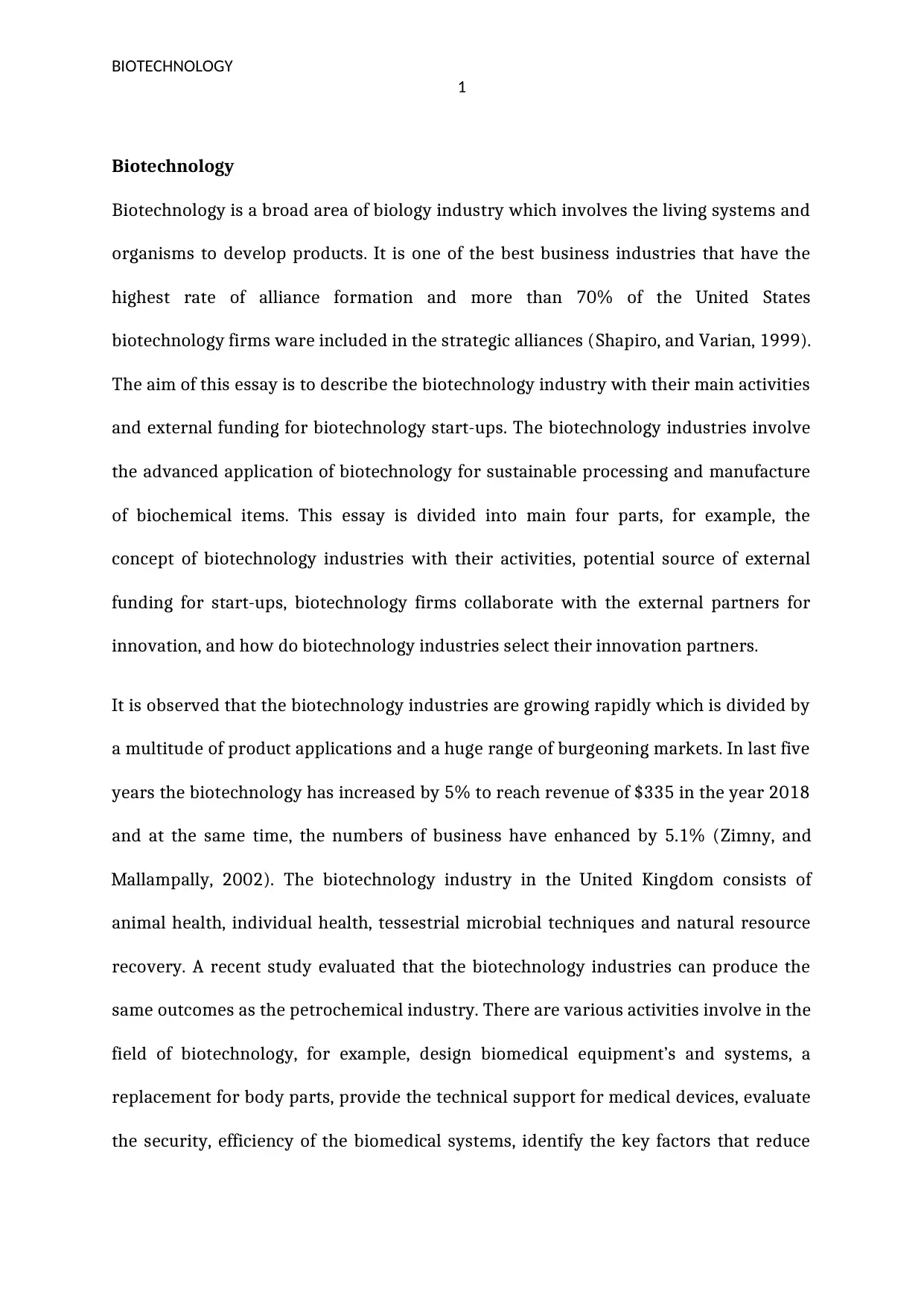
BIOTECHNOLOGY
1
Biotechnology
Biotechnology is a broad area of biology industry which involves the living systems and
organisms to develop products. It is one of the best business industries that have the
highest rate of alliance formation and more than 70% of the United States
biotechnology firms ware included in the strategic alliances (Shapiro, and Varian, 1999).
The aim of this essay is to describe the biotechnology industry with their main activities
and external funding for biotechnology start-ups. The biotechnology industries involve
the advanced application of biotechnology for sustainable processing and manufacture
of biochemical items. This essay is divided into main four parts, for example, the
concept of biotechnology industries with their activities, potential source of external
funding for start-ups, biotechnology firms collaborate with the external partners for
innovation, and how do biotechnology industries select their innovation partners.
It is observed that the biotechnology industries are growing rapidly which is divided by
a multitude of product applications and a huge range of burgeoning markets. In last five
years the biotechnology has increased by 5% to reach revenue of $335 in the year 2018
and at the same time, the numbers of business have enhanced by 5.1% (Zimny, and
Mallampally, 2002). The biotechnology industry in the United Kingdom consists of
animal health, individual health, tessestrial microbial techniques and natural resource
recovery. A recent study evaluated that the biotechnology industries can produce the
same outcomes as the petrochemical industry. There are various activities involve in the
field of biotechnology, for example, design biomedical equipment’s and systems, a
replacement for body parts, provide the technical support for medical devices, evaluate
the security, efficiency of the biomedical systems, identify the key factors that reduce
1
Biotechnology
Biotechnology is a broad area of biology industry which involves the living systems and
organisms to develop products. It is one of the best business industries that have the
highest rate of alliance formation and more than 70% of the United States
biotechnology firms ware included in the strategic alliances (Shapiro, and Varian, 1999).
The aim of this essay is to describe the biotechnology industry with their main activities
and external funding for biotechnology start-ups. The biotechnology industries involve
the advanced application of biotechnology for sustainable processing and manufacture
of biochemical items. This essay is divided into main four parts, for example, the
concept of biotechnology industries with their activities, potential source of external
funding for start-ups, biotechnology firms collaborate with the external partners for
innovation, and how do biotechnology industries select their innovation partners.
It is observed that the biotechnology industries are growing rapidly which is divided by
a multitude of product applications and a huge range of burgeoning markets. In last five
years the biotechnology has increased by 5% to reach revenue of $335 in the year 2018
and at the same time, the numbers of business have enhanced by 5.1% (Zimny, and
Mallampally, 2002). The biotechnology industry in the United Kingdom consists of
animal health, individual health, tessestrial microbial techniques and natural resource
recovery. A recent study evaluated that the biotechnology industries can produce the
same outcomes as the petrochemical industry. There are various activities involve in the
field of biotechnology, for example, design biomedical equipment’s and systems, a
replacement for body parts, provide the technical support for medical devices, evaluate
the security, efficiency of the biomedical systems, identify the key factors that reduce
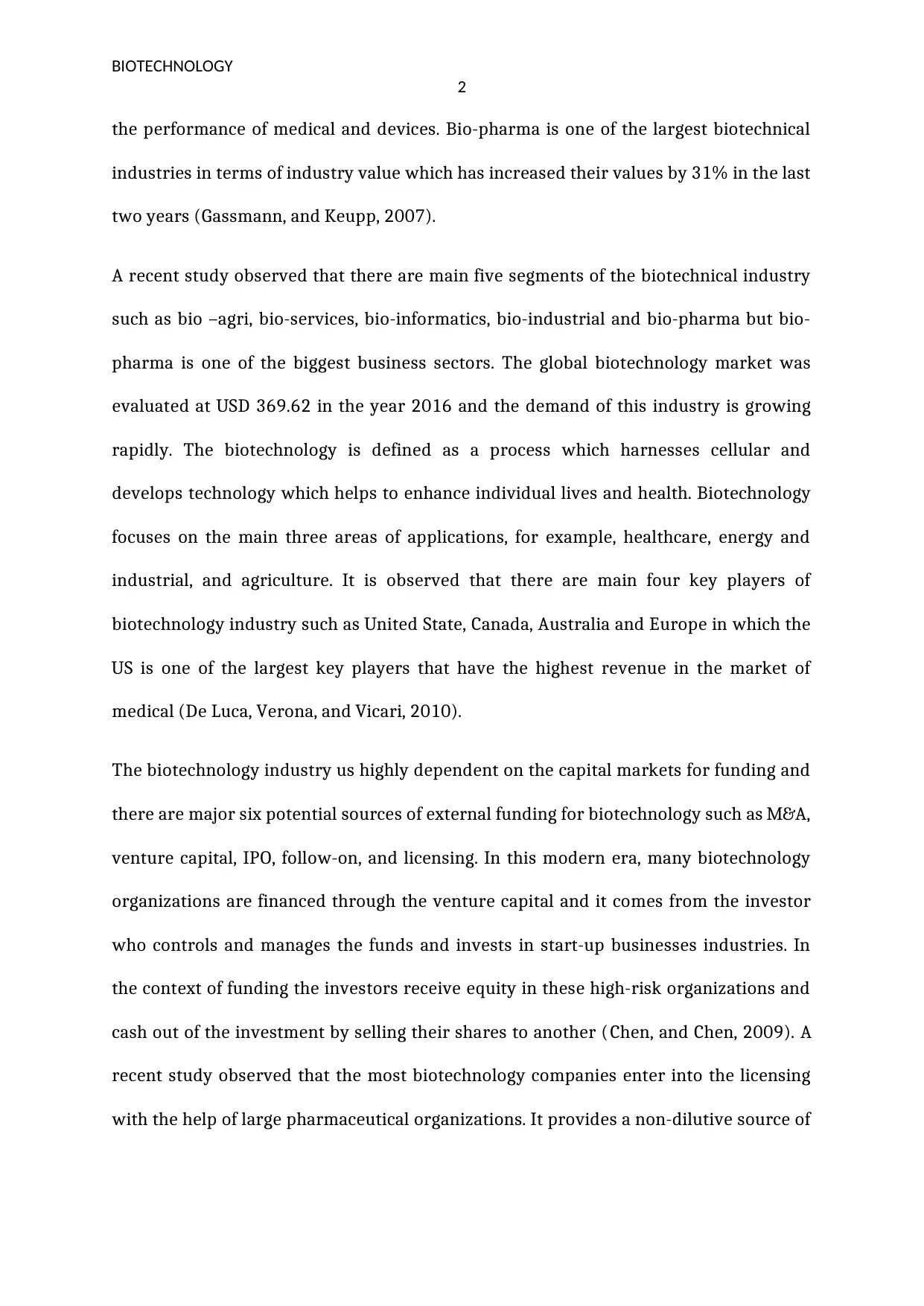
BIOTECHNOLOGY
2
the performance of medical and devices. Bio-pharma is one of the largest biotechnical
industries in terms of industry value which has increased their values by 31% in the last
two years (Gassmann, and Keupp, 2007).
A recent study observed that there are main five segments of the biotechnical industry
such as bio –agri, bio-services, bio-informatics, bio-industrial and bio-pharma but bio-
pharma is one of the biggest business sectors. The global biotechnology market was
evaluated at USD 369.62 in the year 2016 and the demand of this industry is growing
rapidly. The biotechnology is defined as a process which harnesses cellular and
develops technology which helps to enhance individual lives and health. Biotechnology
focuses on the main three areas of applications, for example, healthcare, energy and
industrial, and agriculture. It is observed that there are main four key players of
biotechnology industry such as United State, Canada, Australia and Europe in which the
US is one of the largest key players that have the highest revenue in the market of
medical (De Luca, Verona, and Vicari, 2010).
The biotechnology industry us highly dependent on the capital markets for funding and
there are major six potential sources of external funding for biotechnology such as M&A,
venture capital, IPO, follow-on, and licensing. In this modern era, many biotechnology
organizations are financed through the venture capital and it comes from the investor
who controls and manages the funds and invests in start-up businesses industries. In
the context of funding the investors receive equity in these high-risk organizations and
cash out of the investment by selling their shares to another (Chen, and Chen, 2009). A
recent study observed that the most biotechnology companies enter into the licensing
with the help of large pharmaceutical organizations. It provides a non-dilutive source of
2
the performance of medical and devices. Bio-pharma is one of the largest biotechnical
industries in terms of industry value which has increased their values by 31% in the last
two years (Gassmann, and Keupp, 2007).
A recent study observed that there are main five segments of the biotechnical industry
such as bio –agri, bio-services, bio-informatics, bio-industrial and bio-pharma but bio-
pharma is one of the biggest business sectors. The global biotechnology market was
evaluated at USD 369.62 in the year 2016 and the demand of this industry is growing
rapidly. The biotechnology is defined as a process which harnesses cellular and
develops technology which helps to enhance individual lives and health. Biotechnology
focuses on the main three areas of applications, for example, healthcare, energy and
industrial, and agriculture. It is observed that there are main four key players of
biotechnology industry such as United State, Canada, Australia and Europe in which the
US is one of the largest key players that have the highest revenue in the market of
medical (De Luca, Verona, and Vicari, 2010).
The biotechnology industry us highly dependent on the capital markets for funding and
there are major six potential sources of external funding for biotechnology such as M&A,
venture capital, IPO, follow-on, and licensing. In this modern era, many biotechnology
organizations are financed through the venture capital and it comes from the investor
who controls and manages the funds and invests in start-up businesses industries. In
the context of funding the investors receive equity in these high-risk organizations and
cash out of the investment by selling their shares to another (Chen, and Chen, 2009). A
recent study observed that the most biotechnology companies enter into the licensing
with the help of large pharmaceutical organizations. It provides a non-dilutive source of
⊘ This is a preview!⊘
Do you want full access?
Subscribe today to unlock all pages.

Trusted by 1+ million students worldwide
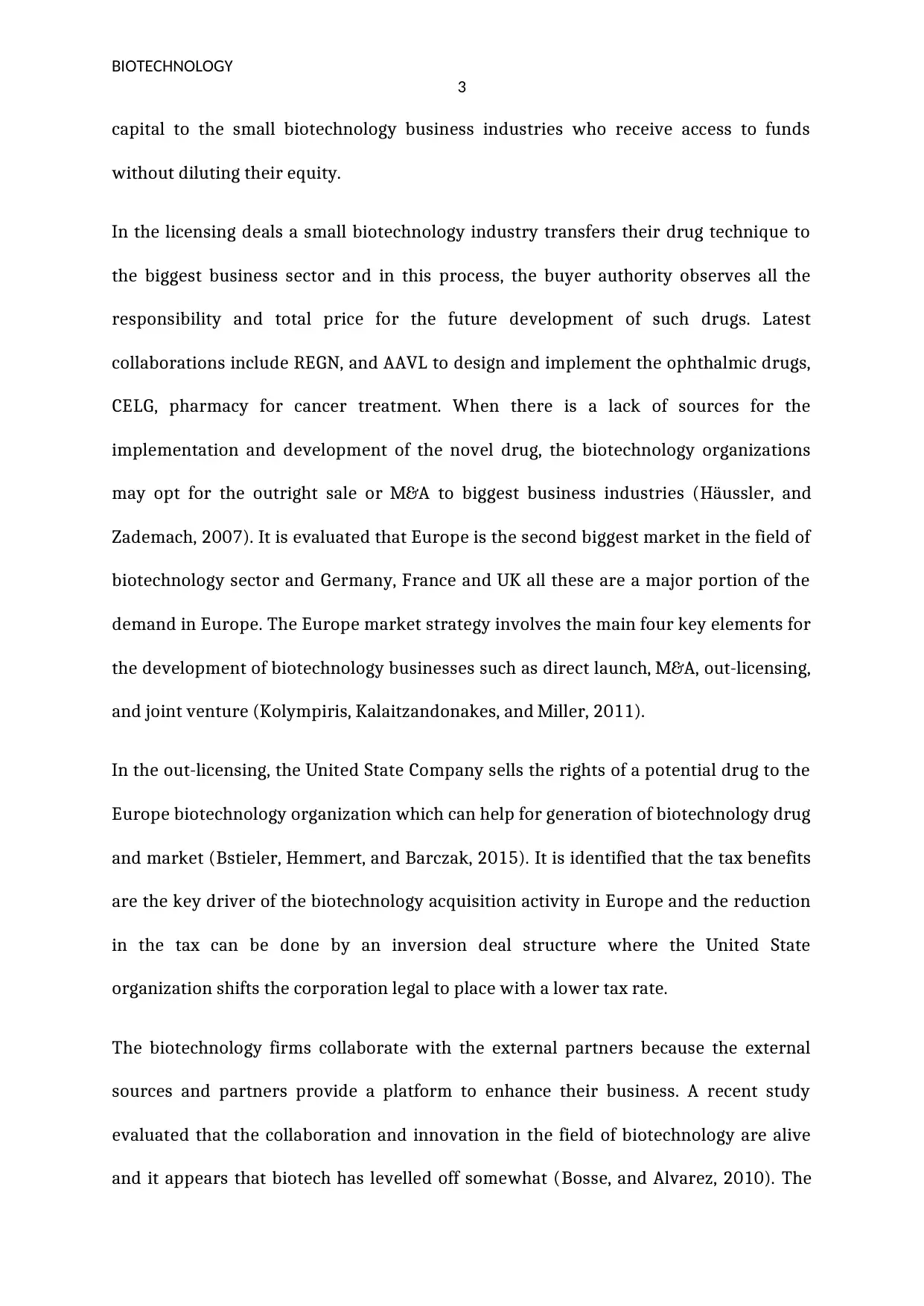
BIOTECHNOLOGY
3
capital to the small biotechnology business industries who receive access to funds
without diluting their equity.
In the licensing deals a small biotechnology industry transfers their drug technique to
the biggest business sector and in this process, the buyer authority observes all the
responsibility and total price for the future development of such drugs. Latest
collaborations include REGN, and AAVL to design and implement the ophthalmic drugs,
CELG, pharmacy for cancer treatment. When there is a lack of sources for the
implementation and development of the novel drug, the biotechnology organizations
may opt for the outright sale or M&A to biggest business industries (Häussler, and
Zademach, 2007). It is evaluated that Europe is the second biggest market in the field of
biotechnology sector and Germany, France and UK all these are a major portion of the
demand in Europe. The Europe market strategy involves the main four key elements for
the development of biotechnology businesses such as direct launch, M&A, out-licensing,
and joint venture (Kolympiris, Kalaitzandonakes, and Miller, 2011).
In the out-licensing, the United State Company sells the rights of a potential drug to the
Europe biotechnology organization which can help for generation of biotechnology drug
and market (Bstieler, Hemmert, and Barczak, 2015). It is identified that the tax benefits
are the key driver of the biotechnology acquisition activity in Europe and the reduction
in the tax can be done by an inversion deal structure where the United State
organization shifts the corporation legal to place with a lower tax rate.
The biotechnology firms collaborate with the external partners because the external
sources and partners provide a platform to enhance their business. A recent study
evaluated that the collaboration and innovation in the field of biotechnology are alive
and it appears that biotech has levelled off somewhat (Bosse, and Alvarez, 2010). The
3
capital to the small biotechnology business industries who receive access to funds
without diluting their equity.
In the licensing deals a small biotechnology industry transfers their drug technique to
the biggest business sector and in this process, the buyer authority observes all the
responsibility and total price for the future development of such drugs. Latest
collaborations include REGN, and AAVL to design and implement the ophthalmic drugs,
CELG, pharmacy for cancer treatment. When there is a lack of sources for the
implementation and development of the novel drug, the biotechnology organizations
may opt for the outright sale or M&A to biggest business industries (Häussler, and
Zademach, 2007). It is evaluated that Europe is the second biggest market in the field of
biotechnology sector and Germany, France and UK all these are a major portion of the
demand in Europe. The Europe market strategy involves the main four key elements for
the development of biotechnology businesses such as direct launch, M&A, out-licensing,
and joint venture (Kolympiris, Kalaitzandonakes, and Miller, 2011).
In the out-licensing, the United State Company sells the rights of a potential drug to the
Europe biotechnology organization which can help for generation of biotechnology drug
and market (Bstieler, Hemmert, and Barczak, 2015). It is identified that the tax benefits
are the key driver of the biotechnology acquisition activity in Europe and the reduction
in the tax can be done by an inversion deal structure where the United State
organization shifts the corporation legal to place with a lower tax rate.
The biotechnology firms collaborate with the external partners because the external
sources and partners provide a platform to enhance their business. A recent study
evaluated that the collaboration and innovation in the field of biotechnology are alive
and it appears that biotech has levelled off somewhat (Bosse, and Alvarez, 2010). The
Paraphrase This Document
Need a fresh take? Get an instant paraphrase of this document with our AI Paraphraser
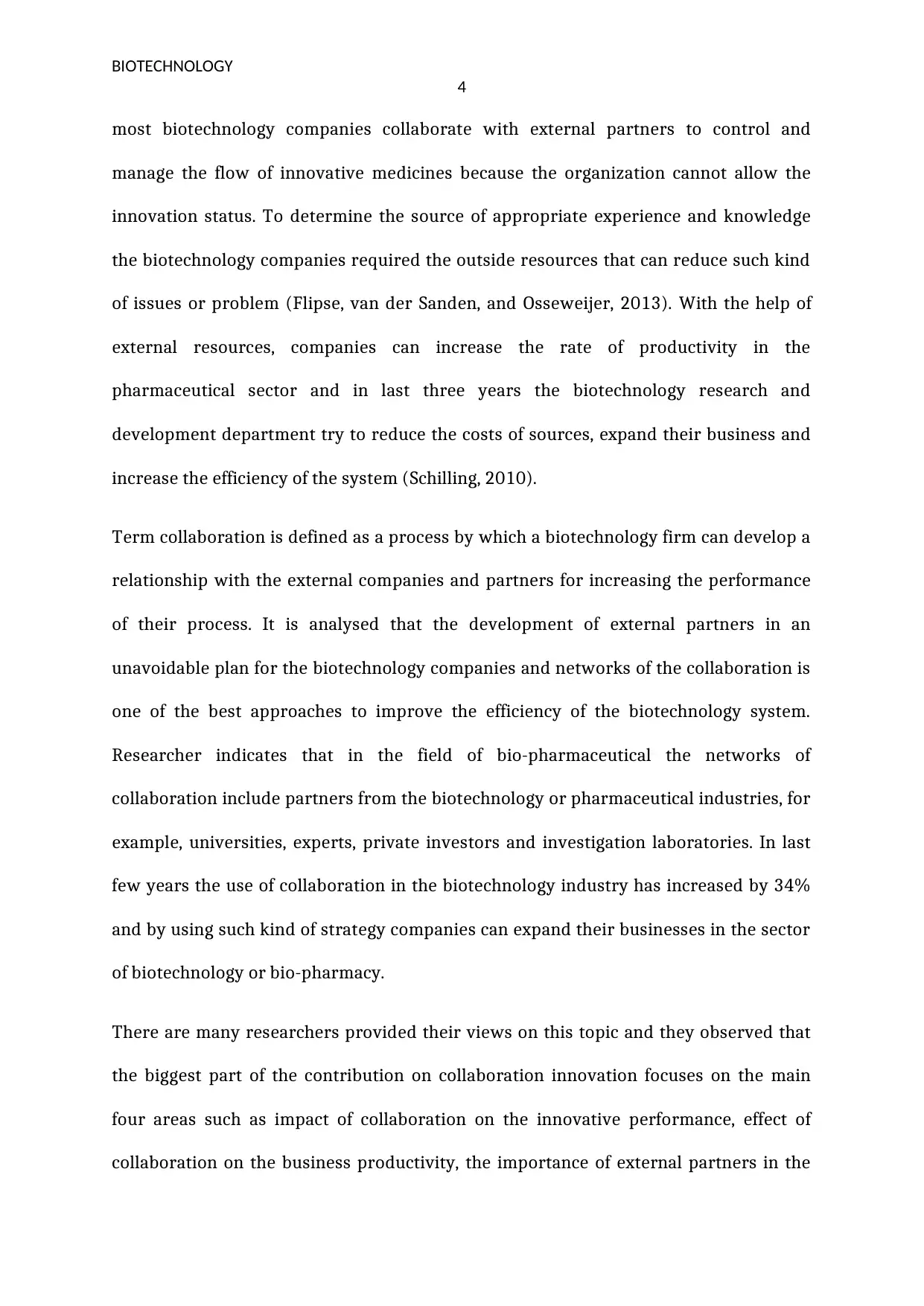
BIOTECHNOLOGY
4
most biotechnology companies collaborate with external partners to control and
manage the flow of innovative medicines because the organization cannot allow the
innovation status. To determine the source of appropriate experience and knowledge
the biotechnology companies required the outside resources that can reduce such kind
of issues or problem (Flipse, van der Sanden, and Osseweijer, 2013). With the help of
external resources, companies can increase the rate of productivity in the
pharmaceutical sector and in last three years the biotechnology research and
development department try to reduce the costs of sources, expand their business and
increase the efficiency of the system (Schilling, 2010).
Term collaboration is defined as a process by which a biotechnology firm can develop a
relationship with the external companies and partners for increasing the performance
of their process. It is analysed that the development of external partners in an
unavoidable plan for the biotechnology companies and networks of the collaboration is
one of the best approaches to improve the efficiency of the biotechnology system.
Researcher indicates that in the field of bio-pharmaceutical the networks of
collaboration include partners from the biotechnology or pharmaceutical industries, for
example, universities, experts, private investors and investigation laboratories. In last
few years the use of collaboration in the biotechnology industry has increased by 34%
and by using such kind of strategy companies can expand their businesses in the sector
of biotechnology or bio-pharmacy.
There are many researchers provided their views on this topic and they observed that
the biggest part of the contribution on collaboration innovation focuses on the main
four areas such as impact of collaboration on the innovative performance, effect of
collaboration on the business productivity, the importance of external partners in the
4
most biotechnology companies collaborate with external partners to control and
manage the flow of innovative medicines because the organization cannot allow the
innovation status. To determine the source of appropriate experience and knowledge
the biotechnology companies required the outside resources that can reduce such kind
of issues or problem (Flipse, van der Sanden, and Osseweijer, 2013). With the help of
external resources, companies can increase the rate of productivity in the
pharmaceutical sector and in last three years the biotechnology research and
development department try to reduce the costs of sources, expand their business and
increase the efficiency of the system (Schilling, 2010).
Term collaboration is defined as a process by which a biotechnology firm can develop a
relationship with the external companies and partners for increasing the performance
of their process. It is analysed that the development of external partners in an
unavoidable plan for the biotechnology companies and networks of the collaboration is
one of the best approaches to improve the efficiency of the biotechnology system.
Researcher indicates that in the field of bio-pharmaceutical the networks of
collaboration include partners from the biotechnology or pharmaceutical industries, for
example, universities, experts, private investors and investigation laboratories. In last
few years the use of collaboration in the biotechnology industry has increased by 34%
and by using such kind of strategy companies can expand their businesses in the sector
of biotechnology or bio-pharmacy.
There are many researchers provided their views on this topic and they observed that
the biggest part of the contribution on collaboration innovation focuses on the main
four areas such as impact of collaboration on the innovative performance, effect of
collaboration on the business productivity, the importance of external partners in the
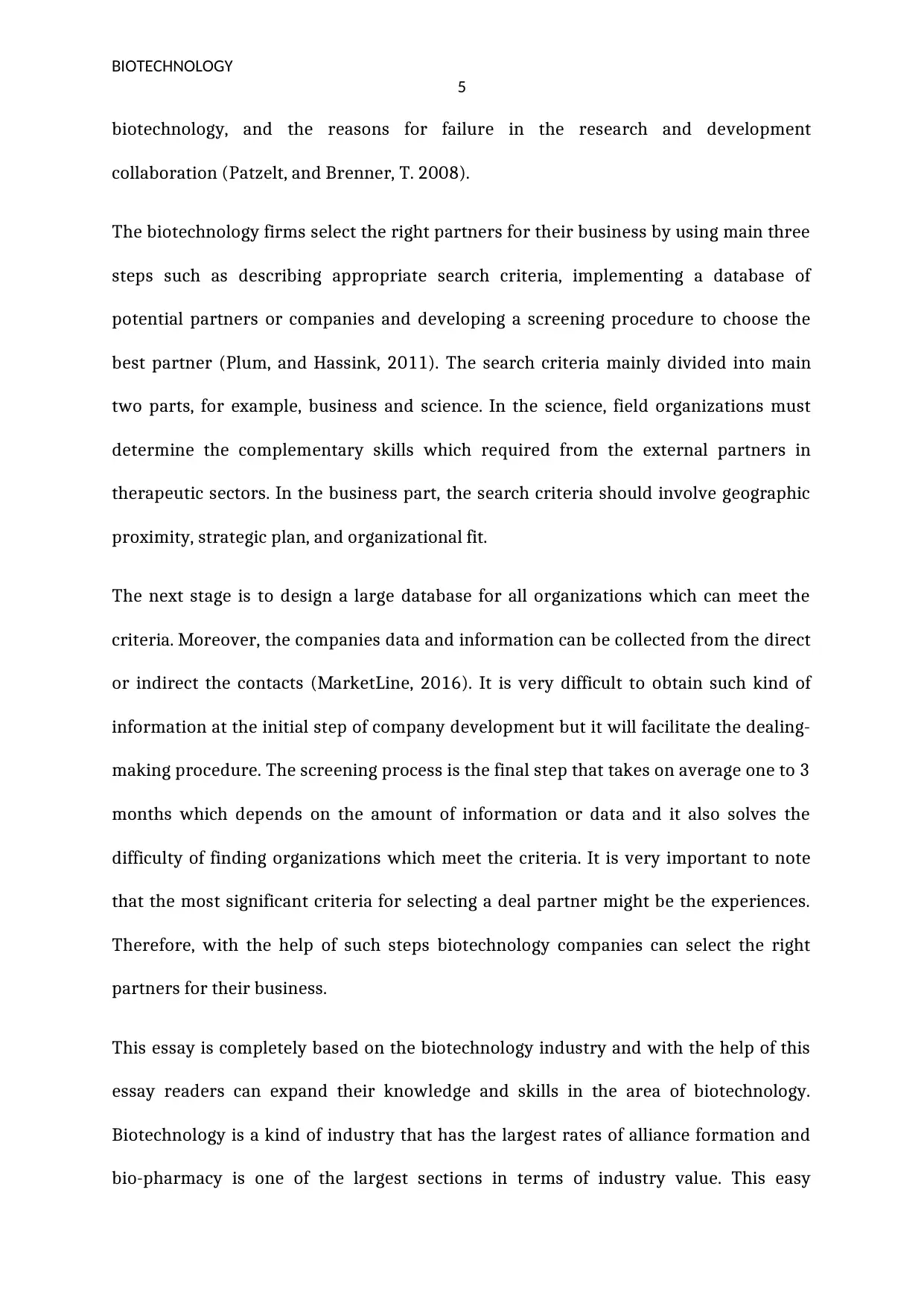
BIOTECHNOLOGY
5
biotechnology, and the reasons for failure in the research and development
collaboration (Patzelt, and Brenner, T. 2008).
The biotechnology firms select the right partners for their business by using main three
steps such as describing appropriate search criteria, implementing a database of
potential partners or companies and developing a screening procedure to choose the
best partner (Plum, and Hassink, 2011). The search criteria mainly divided into main
two parts, for example, business and science. In the science, field organizations must
determine the complementary skills which required from the external partners in
therapeutic sectors. In the business part, the search criteria should involve geographic
proximity, strategic plan, and organizational fit.
The next stage is to design a large database for all organizations which can meet the
criteria. Moreover, the companies data and information can be collected from the direct
or indirect the contacts (MarketLine, 2016). It is very difficult to obtain such kind of
information at the initial step of company development but it will facilitate the dealing-
making procedure. The screening process is the final step that takes on average one to 3
months which depends on the amount of information or data and it also solves the
difficulty of finding organizations which meet the criteria. It is very important to note
that the most significant criteria for selecting a deal partner might be the experiences.
Therefore, with the help of such steps biotechnology companies can select the right
partners for their business.
This essay is completely based on the biotechnology industry and with the help of this
essay readers can expand their knowledge and skills in the area of biotechnology.
Biotechnology is a kind of industry that has the largest rates of alliance formation and
bio-pharmacy is one of the largest sections in terms of industry value. This easy
5
biotechnology, and the reasons for failure in the research and development
collaboration (Patzelt, and Brenner, T. 2008).
The biotechnology firms select the right partners for their business by using main three
steps such as describing appropriate search criteria, implementing a database of
potential partners or companies and developing a screening procedure to choose the
best partner (Plum, and Hassink, 2011). The search criteria mainly divided into main
two parts, for example, business and science. In the science, field organizations must
determine the complementary skills which required from the external partners in
therapeutic sectors. In the business part, the search criteria should involve geographic
proximity, strategic plan, and organizational fit.
The next stage is to design a large database for all organizations which can meet the
criteria. Moreover, the companies data and information can be collected from the direct
or indirect the contacts (MarketLine, 2016). It is very difficult to obtain such kind of
information at the initial step of company development but it will facilitate the dealing-
making procedure. The screening process is the final step that takes on average one to 3
months which depends on the amount of information or data and it also solves the
difficulty of finding organizations which meet the criteria. It is very important to note
that the most significant criteria for selecting a deal partner might be the experiences.
Therefore, with the help of such steps biotechnology companies can select the right
partners for their business.
This essay is completely based on the biotechnology industry and with the help of this
essay readers can expand their knowledge and skills in the area of biotechnology.
Biotechnology is a kind of industry that has the largest rates of alliance formation and
bio-pharmacy is one of the largest sections in terms of industry value. This easy
⊘ This is a preview!⊘
Do you want full access?
Subscribe today to unlock all pages.

Trusted by 1+ million students worldwide

BIOTECHNOLOGY
6
described the concept of the biotechnology industry, the main activity of the
biotechnology, source of external funding for the start-ups and key players of this
industry. There are main three key steps by which the biotechnology sector can select
the best partner which explained in this essay and companies should ensure that
partners or companies meet the criteria of the biotechnology industry.
6
described the concept of the biotechnology industry, the main activity of the
biotechnology, source of external funding for the start-ups and key players of this
industry. There are main three key steps by which the biotechnology sector can select
the best partner which explained in this essay and companies should ensure that
partners or companies meet the criteria of the biotechnology industry.
Paraphrase This Document
Need a fresh take? Get an instant paraphrase of this document with our AI Paraphraser
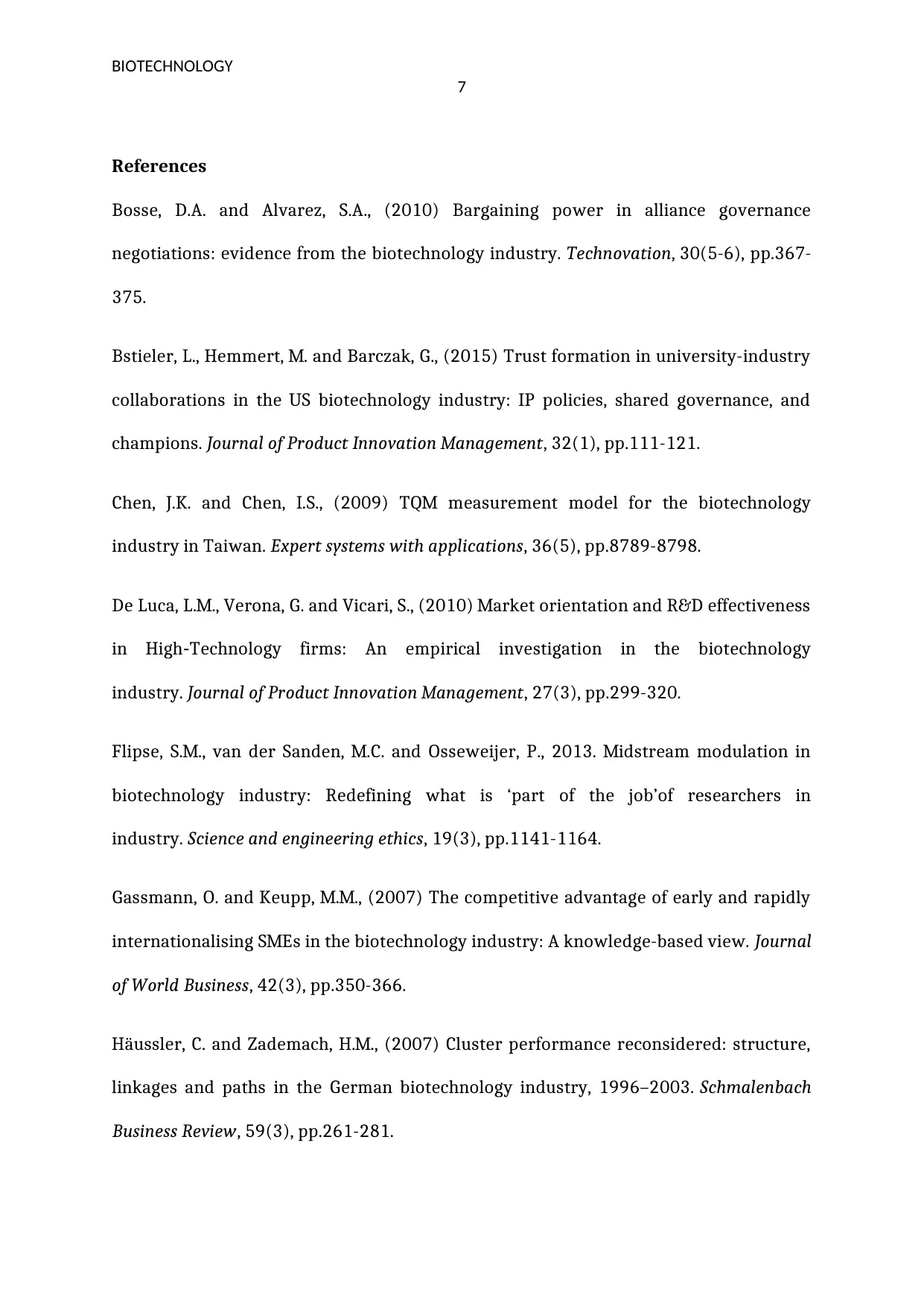
BIOTECHNOLOGY
7
References
Bosse, D.A. and Alvarez, S.A., (2010) Bargaining power in alliance governance
negotiations: evidence from the biotechnology industry. Technovation, 30(5-6), pp.367-
375.
Bstieler, L., Hemmert, M. and Barczak, G., (2015) Trust formation in university-industry
collaborations in the US biotechnology industry: IP policies, shared governance, and
champions. Journal of Product Innovation Management, 32(1), pp.111-121.
Chen, J.K. and Chen, I.S., (2009) TQM measurement model for the biotechnology
industry in Taiwan. Expert systems with applications, 36(5), pp.8789-8798.
De Luca, L.M., Verona, G. and Vicari, S., (2010) Market orientation and R&D effectiveness
in High‐Technology firms: An empirical investigation in the biotechnology
industry. Journal of Product Innovation Management, 27(3), pp.299-320.
Flipse, S.M., van der Sanden, M.C. and Osseweijer, P., 2013. Midstream modulation in
biotechnology industry: Redefining what is ‘part of the job’of researchers in
industry. Science and engineering ethics, 19(3), pp.1141-1164.
Gassmann, O. and Keupp, M.M., (2007) The competitive advantage of early and rapidly
internationalising SMEs in the biotechnology industry: A knowledge-based view. Journal
of World Business, 42(3), pp.350-366.
Häussler, C. and Zademach, H.M., (2007) Cluster performance reconsidered: structure,
linkages and paths in the German biotechnology industry, 1996–2003. Schmalenbach
Business Review, 59(3), pp.261-281.
7
References
Bosse, D.A. and Alvarez, S.A., (2010) Bargaining power in alliance governance
negotiations: evidence from the biotechnology industry. Technovation, 30(5-6), pp.367-
375.
Bstieler, L., Hemmert, M. and Barczak, G., (2015) Trust formation in university-industry
collaborations in the US biotechnology industry: IP policies, shared governance, and
champions. Journal of Product Innovation Management, 32(1), pp.111-121.
Chen, J.K. and Chen, I.S., (2009) TQM measurement model for the biotechnology
industry in Taiwan. Expert systems with applications, 36(5), pp.8789-8798.
De Luca, L.M., Verona, G. and Vicari, S., (2010) Market orientation and R&D effectiveness
in High‐Technology firms: An empirical investigation in the biotechnology
industry. Journal of Product Innovation Management, 27(3), pp.299-320.
Flipse, S.M., van der Sanden, M.C. and Osseweijer, P., 2013. Midstream modulation in
biotechnology industry: Redefining what is ‘part of the job’of researchers in
industry. Science and engineering ethics, 19(3), pp.1141-1164.
Gassmann, O. and Keupp, M.M., (2007) The competitive advantage of early and rapidly
internationalising SMEs in the biotechnology industry: A knowledge-based view. Journal
of World Business, 42(3), pp.350-366.
Häussler, C. and Zademach, H.M., (2007) Cluster performance reconsidered: structure,
linkages and paths in the German biotechnology industry, 1996–2003. Schmalenbach
Business Review, 59(3), pp.261-281.
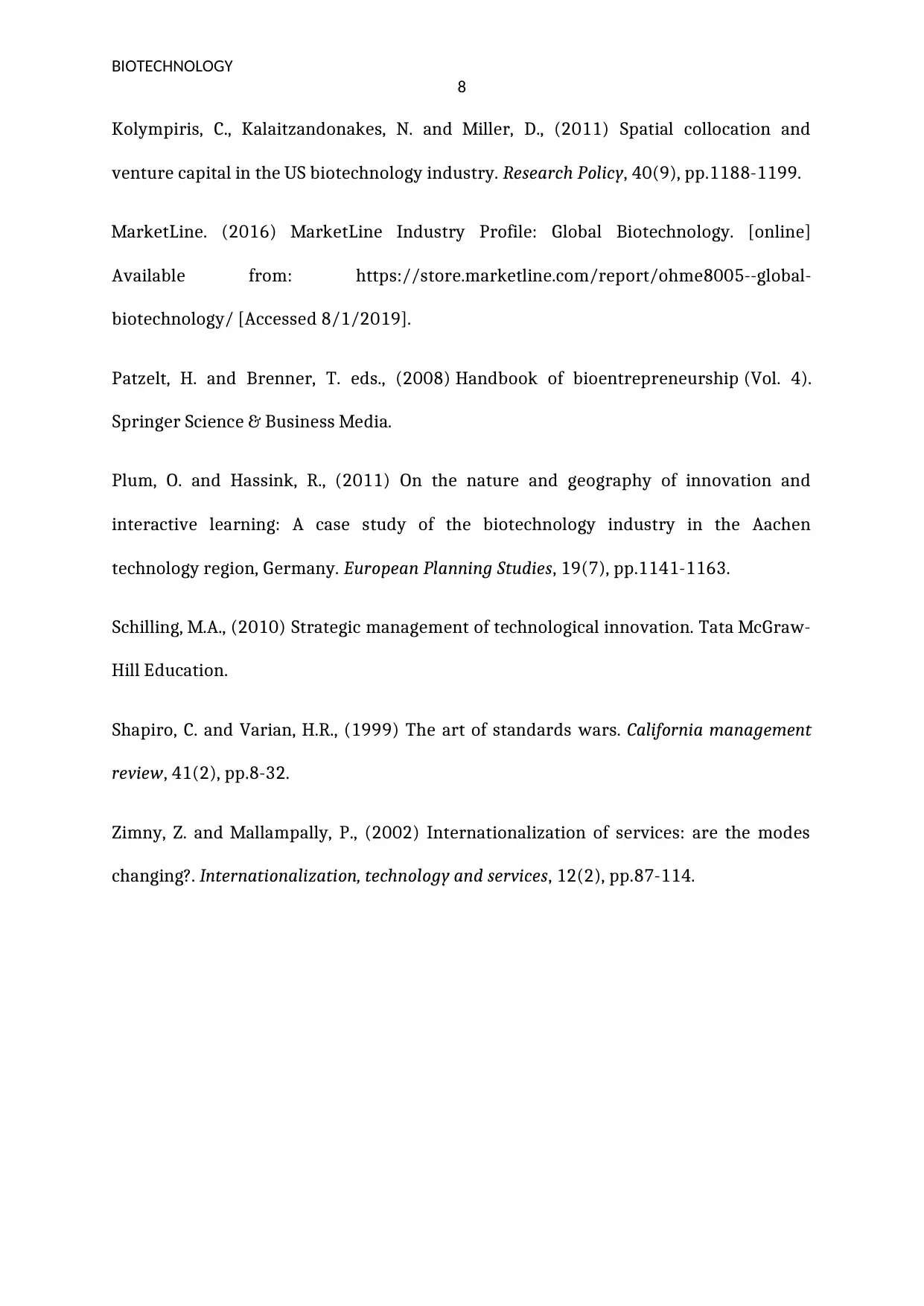
BIOTECHNOLOGY
8
Kolympiris, C., Kalaitzandonakes, N. and Miller, D., (2011) Spatial collocation and
venture capital in the US biotechnology industry. Research Policy, 40(9), pp.1188-1199.
MarketLine. (2016) MarketLine Industry Profile: Global Biotechnology. [online]
Available from: https://store.marketline.com/report/ohme8005--global-
biotechnology/ [Accessed 8/1/2019].
Patzelt, H. and Brenner, T. eds., (2008) Handbook of bioentrepreneurship (Vol. 4).
Springer Science & Business Media.
Plum, O. and Hassink, R., (2011) On the nature and geography of innovation and
interactive learning: A case study of the biotechnology industry in the Aachen
technology region, Germany. European Planning Studies, 19(7), pp.1141-1163.
Schilling, M.A., (2010) Strategic management of technological innovation. Tata McGraw-
Hill Education.
Shapiro, C. and Varian, H.R., (1999) The art of standards wars. California management
review, 41(2), pp.8-32.
Zimny, Z. and Mallampally, P., (2002) Internationalization of services: are the modes
changing?. Internationalization, technology and services, 12(2), pp.87-114.
8
Kolympiris, C., Kalaitzandonakes, N. and Miller, D., (2011) Spatial collocation and
venture capital in the US biotechnology industry. Research Policy, 40(9), pp.1188-1199.
MarketLine. (2016) MarketLine Industry Profile: Global Biotechnology. [online]
Available from: https://store.marketline.com/report/ohme8005--global-
biotechnology/ [Accessed 8/1/2019].
Patzelt, H. and Brenner, T. eds., (2008) Handbook of bioentrepreneurship (Vol. 4).
Springer Science & Business Media.
Plum, O. and Hassink, R., (2011) On the nature and geography of innovation and
interactive learning: A case study of the biotechnology industry in the Aachen
technology region, Germany. European Planning Studies, 19(7), pp.1141-1163.
Schilling, M.A., (2010) Strategic management of technological innovation. Tata McGraw-
Hill Education.
Shapiro, C. and Varian, H.R., (1999) The art of standards wars. California management
review, 41(2), pp.8-32.
Zimny, Z. and Mallampally, P., (2002) Internationalization of services: are the modes
changing?. Internationalization, technology and services, 12(2), pp.87-114.
⊘ This is a preview!⊘
Do you want full access?
Subscribe today to unlock all pages.

Trusted by 1+ million students worldwide
1 out of 9
Your All-in-One AI-Powered Toolkit for Academic Success.
+13062052269
info@desklib.com
Available 24*7 on WhatsApp / Email
![[object Object]](/_next/static/media/star-bottom.7253800d.svg)
Unlock your academic potential
Copyright © 2020–2025 A2Z Services. All Rights Reserved. Developed and managed by ZUCOL.

